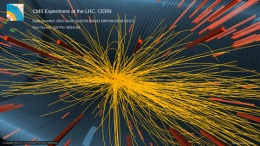Large Hadron Collider scientists spot potential new discovery: CERN

Scientists at the world's biggest atom smasher said Tuesday they appeared to have discovered a previously unobserved phenomenon in their quest to unravel the deepest secrets of the universe.
Results from one of the detectors in the Large Hadron Collider experiment indicated that "some of the particles are intimately linked in a way not seen before in proton collisions," the European Organisation for Nuclear Research (CERN) said on its website.
"The new feature has appeared in our analysis around the middle of July," physicist Guido Tonelli told fellow CERN scientists at a seminar to present the findings from the collider's CMS (Compact Muon Solenoid) detector.
"We have today submitted a paper to expose our findings to the wider (scientific) community," he added, underlining caution and the need for the peer review outside CERN.
Nonetheless, Tonelli, a physicist from Italy's University of Pisa and scientific spokesperson for the CMS detector, underlined that during weeks of cross-checks and critical debate among the team, "we didn't succeed to kill it."
The phenomenon showed up as a "ridge-like structure" on computer mapping graphs based on data from billions of proton collisions in the 3.9-billion-euro (5.2-billion-dollar) machine.
The 27-kilometre (16.8-mile) circular particle accelerator buried under the French-Swiss border is recreating powerful but microscopic bursts of energy that mimic conditions close to the Big Bang that created the universe.
The CMS, one of six experiments around the accelerator, is designed to search for for the elusive and so far theoretical Higgs Boson, commonly nicknamed the "God Particle".
It is also aimed at shedding light on components of dark matter, the mysterious invisible void that makes up 26 percent of the universe.
MIT physicist Gunther Roland, one of the authors of the paper submitted for review, described the latest observation as a "a subtle effect in a complex environment -- careful work is needed to establish its physical origin."
"What we really hope to get is not just ideas, but how to test it," he added during the seminar at CERN's headquarters on the edge of Geneva.
The organisation said it bore "some similarity" with observations in a smaller Ion collider at the US Department of Energy's Brookhaven National Laboratory.
Despite applause from their peers at CERN, the CMS team's interpretation of the observation on Tuesday was vigorously challenged during the meeting as scientists bounced suggestions off each other.
"We are stating facts, facts that there is something that we have not seen before," Tonelli responded, as they began the process of seeking endorsement and an explanation for the observation.
After a shaky start and a 14-month delay, experiments at the LHC have since last November replicated discoveries that took decades to complete at the rival Tevatron accelerator in the United States.
The LHC set records for smashing protons fired in beams approaching the speed of light in March.
More information: Read the full CMS statement: cms.web.cern.ch/cms/News/2010/ … tatementFinal_en.pdf
(c) 2010 AFP



















